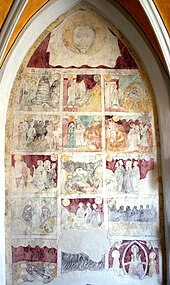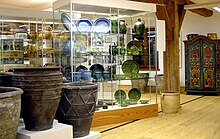Vilsbiburg Local History Museum
The local history museum Vilsbiburg is a folklore museum that was set up with the support of the city of Vilsbiburg in the former Heilig-Geist-Spital (built in the 15th century) and an adjoining house. The historic city tower and a rear building serve as depots.
history

According to initial records, the Heilig-Geist-Spitalkirche was set up in the previous building around 1400 and was financed from 1476 by Pastor Caspar Westendorfer from Landshut. The Vilsbiburg local history museum was opened in 1910 on the initiative of the then mayor Michael Winkler. The motivation was to help “gradually shed light on the history of the place and the Vilsbiburg district, which is almost completely obscured”. The Heimatverein Vilsbiburg e.V., founded in 1928. V. took over the supervision of the museum, which was done on a voluntary basis from the beginning. In 1973, the exhibitions within the hospital building were significantly expanded with the simultaneous repositioning of the collections. Purchase of an additional building complex by the city of Vilsbiburg in 1981. A neighboring building was moved into in 1995. Another permanent exhibition was added in 2005.
Exhibitions
Overall, the following departments are available to visitors on an area of around 1000 m² in temperature-controlled rooms:
- Brick beater and brick burner
- Kröninger pottery
- Social institutions (Heilig-Geist-Spital, Women's Association of the Red Cross , Leprosy House )
- Local history of the place with the structural development of Vilsbiburg and its position as a central market place
- Prehistory and early history (finds from geological history from a tusk elephant to the Stone Age and the Middle Ages)
- Topography, traffic routes (postal network, road and bridge construction)
- Benedikt Auer room
- Hospital Church
- Eduard Schleich the Elder Ä.
- Food industry
- Textile and leather
Brickworkers and brick makers in the Vilsbiburg Land
Clay has been extracted since the Middle Ages. The first handicraft businesses emerged as early as the middle of the 14th century. The newest department of the museum documents historical peculiarities, for example the brick privilege, the nobility and monasteries, cities and markets up to the 18th century defended with tooth and nail because it secured them safe sources of income, but the decay of the building fabric, especially in the country dragged on and led to a serious shortage of wood. The exhibition reports on the construction boom of the 19th century, which was triggered by the construction of bridges and train stations, which caused brick towns to spring up and which probably brought the first Italian guest workers to Lower Bavaria in large numbers. Year after year whole family groups came from Friuli , initially on foot and later by train, to earn their living in the local brick factories. In cooperation with the twin town Buja , it was possible to document the names of more than 2,300 Italian brickworkers in the Vilsbiburger Land alone.
Kröninger Hafnerkeramik
In the Hafnerei the western Lower Bavaria was crafted pottery by artisans from Kröning, produced. The museum presents around 900 exhibits. In the heyday in the 18th century, the sale took place within a radius of several hundred kilometers. By 1800 the annual production reached one million pieces of tableware. The country descriptions of the 18th and 19th centuries, but also the archives of the crafts and the parish archive in Kirchberg im Kröning provide information on how widespread the goods were, namely from the Upper Palatinate to South Tyrol and from Augsburg to Linz. They also provide information on how the distribution took place: If the stoners did not transport their goods themselves, they were brought in by neighboring farmers in the wagons, in the "Kreinzenwagen", the "Karren", the "Kraxe" and the "Schlitten", but also on ships and rafts to the market place, with shopkeepers, traders and carters from areas that were sometimes far away to pick up the goods themselves in the Kröning. In the 20th century, goods were also loaded by rail, via the Vilsbiburg and Wörth an der Isar stations , or picked up by truck from the workshops by dealers like Hörhager from Munich. Due to industrial production, the need for handicrafts decreased and gradually disappeared in the 20th century.
Social facilities.
The Heilig-Geist-Spital was formally founded in 1476, but may be based on an institution that had existed a few years earlier. As elsewhere in the towns, the hospital buildings set decisive accents in the cityscape. Every hospital belongs to a church, which in old Bavaria often has the patronage of the Holy Spirit. In the early days, the hospital activity extended to all needy. Until it was dissolved in 1979, the hospital not only cared for the poor, but also generally social outsiders such as the sick, widows and orphans, but also pilgrims and travelers.
In Vilsbiburg, on February 6, 1870, a “Women's Association of the Red Cross ” was founded. In peacetime, the tasks are limited to supporting people in need through no fault of their own. In 1899 the association had 144 members, and in 1909 it had 244 members.
In 1571 the Vilsbiburg-based brewer Hans Degenbeck donated a new leper house on the occasion of the death of his wife and other female servants. The copy of the deed of foundation reports, however, of an already existing infirmary, which was located opposite the new building. For fear of the contagious leprosy disease , like in Vilsbiburg, leper houses were built far away from the town center.
Local history, jurisdiction, craft organization.
The development of the place from the first mention in the year 1000 as "Pipurch", its designation as a market with city rights in 1308, and its development to this day, occupies a large area. Significant periods are the plague epidemic in 1648, from which around half of the population died, the conversion of the district court into a district court, district office and notary's office, the final elevation to the city and the settlement of modern industrial companies.
Hospital Church
It was not until the year 2000 that a wall painting, a cycle of 15 pictures, was discovered in the Gothic chapel next to the city tower during repair work. This Secco painting is a painting "al secco" - "to dry land." The custodian of the Göttweig Abbey in Lower Austria, Father Gregor Martin Lechner, identified it as a rare representation of the “spiritual Advent and the Second Coming of the Lord”.
The people of the late Middle Ages who were largely ignorant of reading and writing had to be visually brought closer to the announcement of the Last Judgment according to the evangelist Luke (( Lk 21.25 EU )): On the first day the sea rises over all mountains and formed one Kind of wall. On the second day the sea disappears. On the third day the sea monster appears. On the fourth day the sea and all water burns up. On the fifth day, blood-colored dew dripped from trees and herbs, and all the birds gathered on the ground. On the sixth day, fiery lightning destroys the cities. On the seventh day the rocks hit with a loud roar. On the eighth day, a great earthquake rises, devouring humans and animals. The ninth day levels all mountains and hills. On the tenth day, people come out of the caves into which they have taken refuge and go crazy. On the eleventh day, the dead rise from their graves. The twelfth day sees all the stars and planets fall from the sky. On the 13th day, all living die so that they can rise with the dead. On the 14th day heaven and earth burn up, while on the 15th day Christ appears as the judge of the world, before whom all risen must stand.
Literature (selection)
- In the series "Vilsbiburger Museumsschriften" catalogs for the special exhibitions were published:
- No. 14: “… art ennobles me.” The life and work of the landscape painter Eduard Schleich the Elder. Ä. (1812-1874), ISBN 978-3-9811826-8-2 .
- No. 13: "... a lot of delicious wax figures". The Lechner gingerbread and wax puller family in Vilsbiburg
- No. 12: The city of Vilsbiburg and its 100-year-old local museum
- No. 11: Portrait of Vilsbiburger. Citizens from the 18th century to the beginning of the 20th century. 2009, ISBN 978-3-9811826-3-7 .
- No. 10: The warlike 20th century: From the first German republic in 1918 through the dictatorship to a new beginning in 1948 - Vilsbiburg in this area of tension.
- No. 9: Between the milkweed and the bow. Festschrift for Lambert Grasmann. 2007.
- No. 8: Unknown Kröning - rarities from the depot of the Vilsbiburg Hafnermuseum. ISBN 978-3-00-021135-5 .
- Standard work on Kröninger Hafnerkeramik: Lambert Grasmann: The Hafner on the Kröning and on the Bina. Cl. Attenkofer'sche book and art print, Straubing 2010, ISBN 978-3-936511-83-3 .
Web links and individual references based on them
- ↑ Brickworkers and brick makers in the Vilsbiburg region on the website of the Vilsbiburg Local History Museum
- ↑ Kröninger Hafnerei on the website of the Vilsbiburg Local History Museum
- ↑ The Heilig-Geist-Spital on the website of the Vilsbiburg Local History Museum
- ^ The Red Cross on the Vilsbiburg Local History Museum website
- ↑ The Leper House on the Vilsbiburg Local History Museum website
Coordinates: 48 ° 26 ′ 58.1 ″ N , 12 ° 21 ′ 13.2 ″ E

